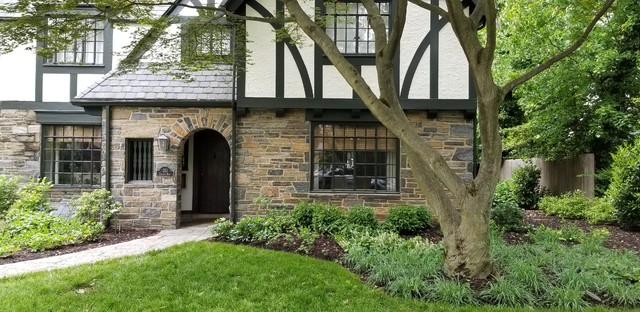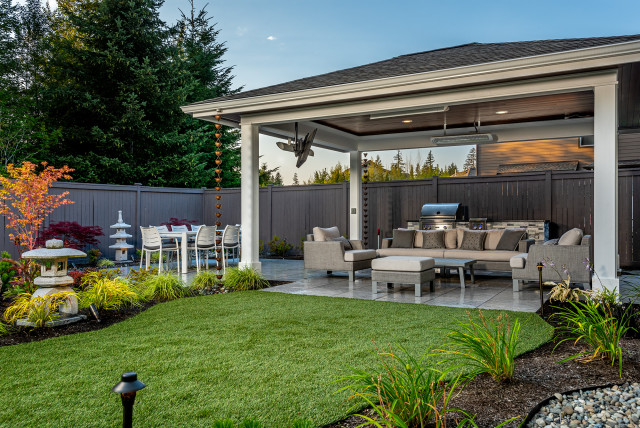For those who want a beautiful garden but would rather not spend hours every week — or hire a staff — to maintain it, consider the following advice from landscape pros on Houzz. It’s important to point out that a low-maintenance landscape doesn’t mean no maintenance at all. “All gardens require maintenance, just like your house requires upkeep,” says landscape designer Todd Haiman in New York City. Still, there are plenty of ways you can create a lush, abundant design that also is easy to care for.
2. Turn to Natives
Native plants are a favorite jumping-off point for landscape pros when they’re designing a low-maintenance garden. “Plants indigenous to your area will result in lower maintenance needs, as they are well adapted to your natural soils, precipitation patterns and microclimates,” landscape designer Isara Ongwiseth of FormLA Landscaping says.
Oscar Ortega, who oversees maintenance for FormLA Landscaping, adds that native species do not need fertilizers or pesticides, which cuts down on maintenance while also supporting wildlife habitats.
Landscape designer Deborah Gliksman of Urban Oasis Landscape Design is another champion of native plants for the same reasons. She adds that native species often use less water than many nonnative exotics in her Southern California locale, where water considerations are a must, and help restore natural biodiversity.
Native plants are a favorite jumping-off point for landscape pros when they’re designing a low-maintenance garden. “Plants indigenous to your area will result in lower maintenance needs, as they are well adapted to your natural soils, precipitation patterns and microclimates,” landscape designer Isara Ongwiseth of FormLA Landscaping says.
Oscar Ortega, who oversees maintenance for FormLA Landscaping, adds that native species do not need fertilizers or pesticides, which cuts down on maintenance while also supporting wildlife habitats.
Landscape designer Deborah Gliksman of Urban Oasis Landscape Design is another champion of native plants for the same reasons. She adds that native species often use less water than many nonnative exotics in her Southern California locale, where water considerations are a must, and help restore natural biodiversity.
3. Pare Down Your Plant List
Elizabeth Przygoda-Montgomery of Boxhill in Tucson, Arizona, recommends keeping your plant list very simple as a way to cut down on maintenance. Once you’ve narrowed down your list, “I would keep it all evergreen, as that means very little shedding,” the landscape designer says.
Elizabeth Przygoda-Montgomery of Boxhill in Tucson, Arizona, recommends keeping your plant list very simple as a way to cut down on maintenance. Once you’ve narrowed down your list, “I would keep it all evergreen, as that means very little shedding,” the landscape designer says.
4. Think Small
Landscape architect Bryan Navarro of Alderwood Landscape Architecture and Construction is a fan of using small to medium varieties of evergreen shrubs and grasses. “Overgrown plants need tidying up and require trimming back, while smaller or dwarf varieties grow to a mature size that fits comfortably in every garden,” the Bellevue, Washington, pro says.
Haiman also steers clients towards slower-growing and dwarf varieties of trees and shrubs, which are generally easier to maintain.
Landscape architect Bryan Navarro of Alderwood Landscape Architecture and Construction is a fan of using small to medium varieties of evergreen shrubs and grasses. “Overgrown plants need tidying up and require trimming back, while smaller or dwarf varieties grow to a mature size that fits comfortably in every garden,” the Bellevue, Washington, pro says.
Haiman also steers clients towards slower-growing and dwarf varieties of trees and shrubs, which are generally easier to maintain.
5. Choose Easy-Care Varieties
If your heart is set on at least one or two higher-maintenance plants, consider low-fuss varieties of them. If you’d like roses in your garden, for example, “choose Knock Out roses rather than David Austin roses,” Haiman says.
If your heart is set on at least one or two higher-maintenance plants, consider low-fuss varieties of them. If you’d like roses in your garden, for example, “choose Knock Out roses rather than David Austin roses,” Haiman says.
6. Plant for the Future
Check the mature size of your plants and place them accordingly. “There should be enough space for each plant to grow to its full size,” Gliksman says. If the plant is too large for your chosen spot, she adds, you will be throwing your money away at best or faced with a dire problem — roots might invade your water pipes or break walls, for instance — at worst.
Check the mature size of your plants and place them accordingly. “There should be enough space for each plant to grow to its full size,” Gliksman says. If the plant is too large for your chosen spot, she adds, you will be throwing your money away at best or faced with a dire problem — roots might invade your water pipes or break walls, for instance — at worst.
7. Outwit Weeds
Even in a low-maintenance landscape, be prepared to deal with the inevitable weeds. “Weeds will grow in the middle of a concrete parking lot, so they will certainly find your garden,” says landscape designer Jeff True of Hursthouse Landscape Architects and Contractors.
To help fight weeds, pros recommend filling the gaps between larger plants with low-growing plants and ground covers. “Plant your gardens densely so weeds don’t have an opportunity to grow, and those that do are disguised by desirable plants,” Armillei says. Ortega adds that you can strategically add smaller plants to eventually fill in the bald spots.
Even in a low-maintenance landscape, be prepared to deal with the inevitable weeds. “Weeds will grow in the middle of a concrete parking lot, so they will certainly find your garden,” says landscape designer Jeff True of Hursthouse Landscape Architects and Contractors.
To help fight weeds, pros recommend filling the gaps between larger plants with low-growing plants and ground covers. “Plant your gardens densely so weeds don’t have an opportunity to grow, and those that do are disguised by desirable plants,” Armillei says. Ortega adds that you can strategically add smaller plants to eventually fill in the bald spots.
8. Bring In Mulch
Mulch is both a weed barrier and a finishing touch. “Mulch your yard in the spring and winter,” Navarro says. It creates a barrier that holds water in like a sponge during warmer months. In winter it provides beneficial insulation from hard frosts that can damage roots and plants.
You’ll find a number of choices for organic mulch, including plants. Haiman recommends a living mulch of low-growing ground covers, which will contribute to overall soil health. Landscape designer Linda Greenberg in Charleston, South Carolina, prefers a premium hardwood mulch.
Mulch is both a weed barrier and a finishing touch. “Mulch your yard in the spring and winter,” Navarro says. It creates a barrier that holds water in like a sponge during warmer months. In winter it provides beneficial insulation from hard frosts that can damage roots and plants.
You’ll find a number of choices for organic mulch, including plants. Haiman recommends a living mulch of low-growing ground covers, which will contribute to overall soil health. Landscape designer Linda Greenberg in Charleston, South Carolina, prefers a premium hardwood mulch.
9. Make Watering Easy
All plants need water to survive, but it’s essential to get it right when the garden’s starting out. “Even drought-tolerant plants need to be watered well during the first year and a half until they are well established,” Gliksman says.
The pros we spoke with recommend setting up an irrigation system and working with a professional if possible. “I always have a professionally installed irrigation system to ensure the health of the garden,” Greenberg says.
Navarro also advises adding an irrigation system. “You’ll avoid having to constantly drag out a hose and water plants each day,” he says. A drip irrigation system can reduce water usage and associated costs too.
All plants need water to survive, but it’s essential to get it right when the garden’s starting out. “Even drought-tolerant plants need to be watered well during the first year and a half until they are well established,” Gliksman says.
The pros we spoke with recommend setting up an irrigation system and working with a professional if possible. “I always have a professionally installed irrigation system to ensure the health of the garden,” Greenberg says.
Navarro also advises adding an irrigation system. “You’ll avoid having to constantly drag out a hose and water plants each day,” he says. A drip irrigation system can reduce water usage and associated costs too.
10. Simplify Garden Tasks
Both True and Armillei suggest an incremental approach to garden tasks. “Tend to your garden in small, frequent visits to catch things early, rather than one or two marathon gardening sessions,” True says. Armillei recommends spending a few minutes a week cutting down weeds that are about to flower or seed.
Both True and Armillei suggest an incremental approach to garden tasks. “Tend to your garden in small, frequent visits to catch things early, rather than one or two marathon gardening sessions,” True says. Armillei recommends spending a few minutes a week cutting down weeds that are about to flower or seed.
For dealing with fallen leaves, Armillei recommends mowing over them and then blowing them into the garden beds to decompose, reducing the amount of mulch you’ll need to add in spring. “This also provides valuable habitat for native insects, like lightning bugs,” she says.
Finally, don’t feel guilty if you put off or omit cutting back plants in the fall. “Leaving your spent native blooms and their seedbeds on the plant will feed your local wildlife,” Gliksman says.
Finally, don’t feel guilty if you put off or omit cutting back plants in the fall. “Leaving your spent native blooms and their seedbeds on the plant will feed your local wildlife,” Gliksman says.
Source: www.houzz.com
















Start by choosing plants that will thrive in your landscape’s microclimates. “The right plant in the right place is always going to be lower maintenance,” landscape designer Lee Armillei of Athyrium Design says — as opposed to forcing a plant to grow where it doesn’t want to be. The Pennsylvania pro adds that matching a plant’s needs and location also will result in a healthier specimen overall, which in turn means it will require less care.